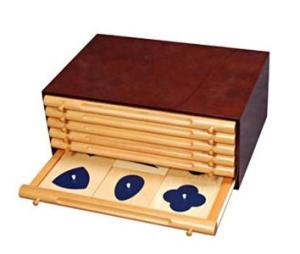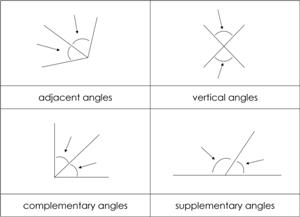As with many curricular areas, geometry in Montessori is quite different than it is in traditional education. Almost all of the study is hands-on, using wooden shapes and nomenclature cards to teach geometric concepts.
This is very important when it comes to geometry, as research shows that it takes children a long time to be able to picture shapes correctly in their minds, and even longer to be able to mentally “rotate” them. Working with them in a hands-on manner helps immensely.
Where Did Geometry Come From?
Geometry is one of the oldest studies in human existence. The beginnings of geometry can be traced back to ancient Egypt, from around 3000 BC. (You might want to check out my Story of Geometry for a neat way to tell kids about these ancient beginnings). Since geo means “earth” and metria means “measure”, early geometry was all about measuring the earth to determine boundaries of ownership.
Geometry was originally a very practical science (as opposed to theoretical), involving measurements, areas, and volume. Important early discoveries include formulas for determining lengths, areas, and volumes; circumference and area of a circle; area of a triangle; volume of a cylinder, sphere, and pyramid. Quickly, geometry began to be applied to many other disciplines, most notably astronomy. The intersection of astronomy and geometry enabled scientists to determine the placement and movement of stars and planets.
Geometry through the Senses
 In Montessori, we start working with shapes and patterns early. The Sensorial area of the 3-6 classroom is really the study of geometry; in elementary, this area becomes geometry. Early geometry materials include the triangle boxes, the geometric cabinet, and the geometric bases and solids. We call these early studies “Exploration of Forms”. (Thanks to Alison’s Montessori for the geometric cabinet picture!)
In Montessori, we start working with shapes and patterns early. The Sensorial area of the 3-6 classroom is really the study of geometry; in elementary, this area becomes geometry. Early geometry materials include the triangle boxes, the geometric cabinet, and the geometric bases and solids. We call these early studies “Exploration of Forms”. (Thanks to Alison’s Montessori for the geometric cabinet picture!)
In these early activities, children are simply learning the names of shapes and beginning to associate the name with the shape. In true Montessori fashion, the early geometry activities also increase hand/eye coordination and fine motor skills as the child traces the outline of the shape with a fingertip or pencil.
Naming & Knowing
 After the child has explored forms and shapes, they are invited to understand figures and their details. These are the nomenclature cards (or geometry folders) that comprise much of the 6-9 geometry curriculum. (See picture: Types of Angle Pairs). Additional materials include the geometry stick box and command cards. Now, the child is learning the different parts and types of lines, angles, triangles, and other shapes.
After the child has explored forms and shapes, they are invited to understand figures and their details. These are the nomenclature cards (or geometry folders) that comprise much of the 6-9 geometry curriculum. (See picture: Types of Angle Pairs). Additional materials include the geometry stick box and command cards. Now, the child is learning the different parts and types of lines, angles, triangles, and other shapes.
The difference between 3-6 and 6-9, as in any curricular area, is this: the child in 6-9 is discovering the properties of whatever it is they explored sensorially in 3-6. The child begins to understand simple definitions and express concepts in their own words. Besides the ready-made geometry materials (both wooden and printed), I find it helpful to keep small wooden sticks (found at craft stores) and string available in the geometry area for freeform exploration.
The Golden Elements of Geometry
In 9-12, the child is introduced to three great concepts of geometry: congruence, similarity, and equivalence. These concepts are referred to as the “Golden Elements” of geometry. The dynamic aspect of this level includes taking figures apart, moving them about, and then putting them back together in such a way that they show equivalency to another figure. For example, a child might reconfigure a triangle to show that it is equivalent to a particular rectangle.
The nomenclature cards at this level include the Golden Elements as well as terminology for figures, including such terms as height, width, and base, area, and volume. Children at this level will also enjoy researching and learning about famous names from geometry, including Pythagoras, Euclid, and Archimedes. I’m a big fan of using books to teach these sorts of concepts; you’ll find a few geometry titles listed here under the 9-12 age group.
Measuring Our Earth
Geometry should be fun! Shapes are all around us, and we use the concepts of geometry every day without realizing it. By introducing children to geometry step-by-step, we insure their firm grasp of concepts as well as enjoyment of the exploration that comes naturally when we measure the earth and everything in it.
Note: the Comprehensive Lists include a section for geometry, listing all the materials and concepts for geometry in each age group. Very helpful!
